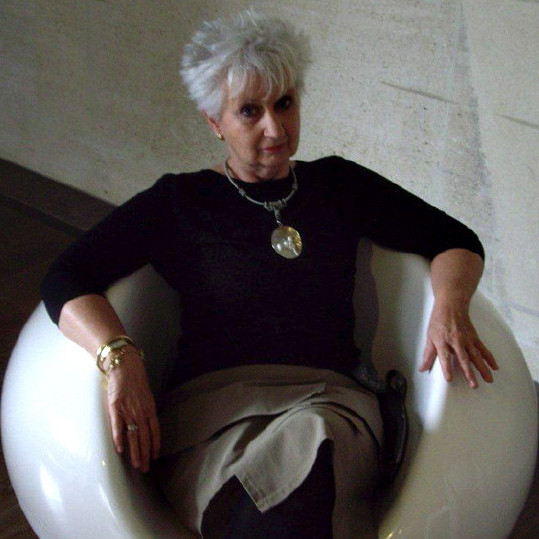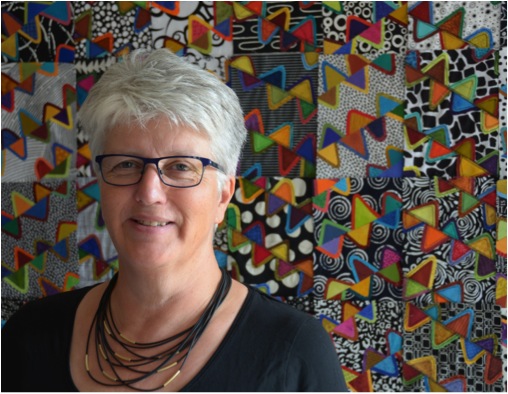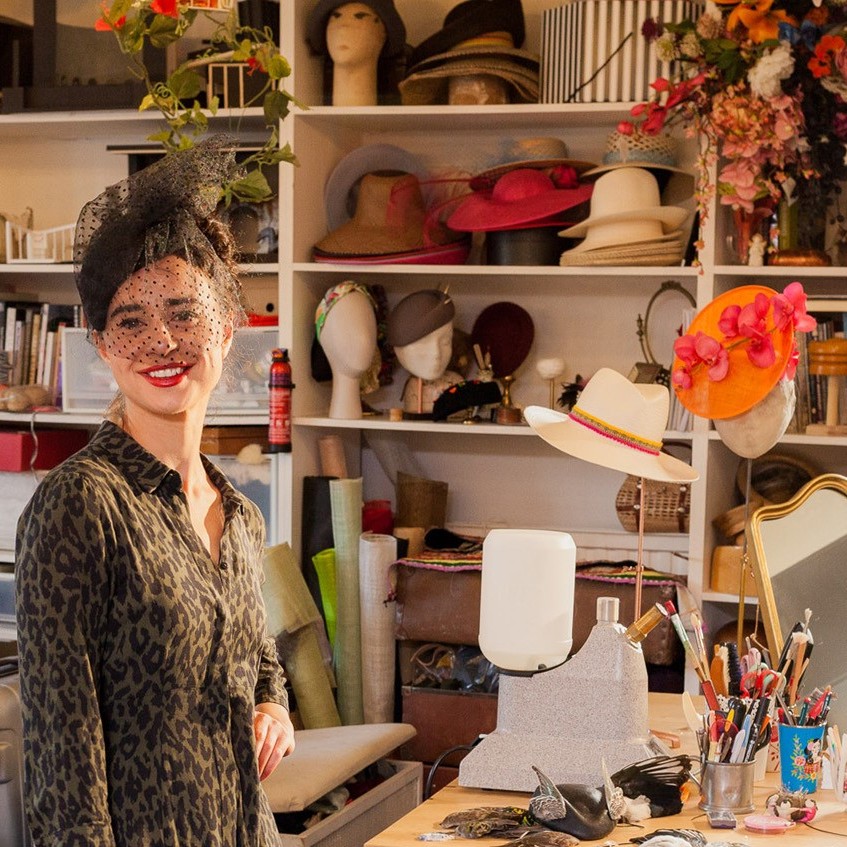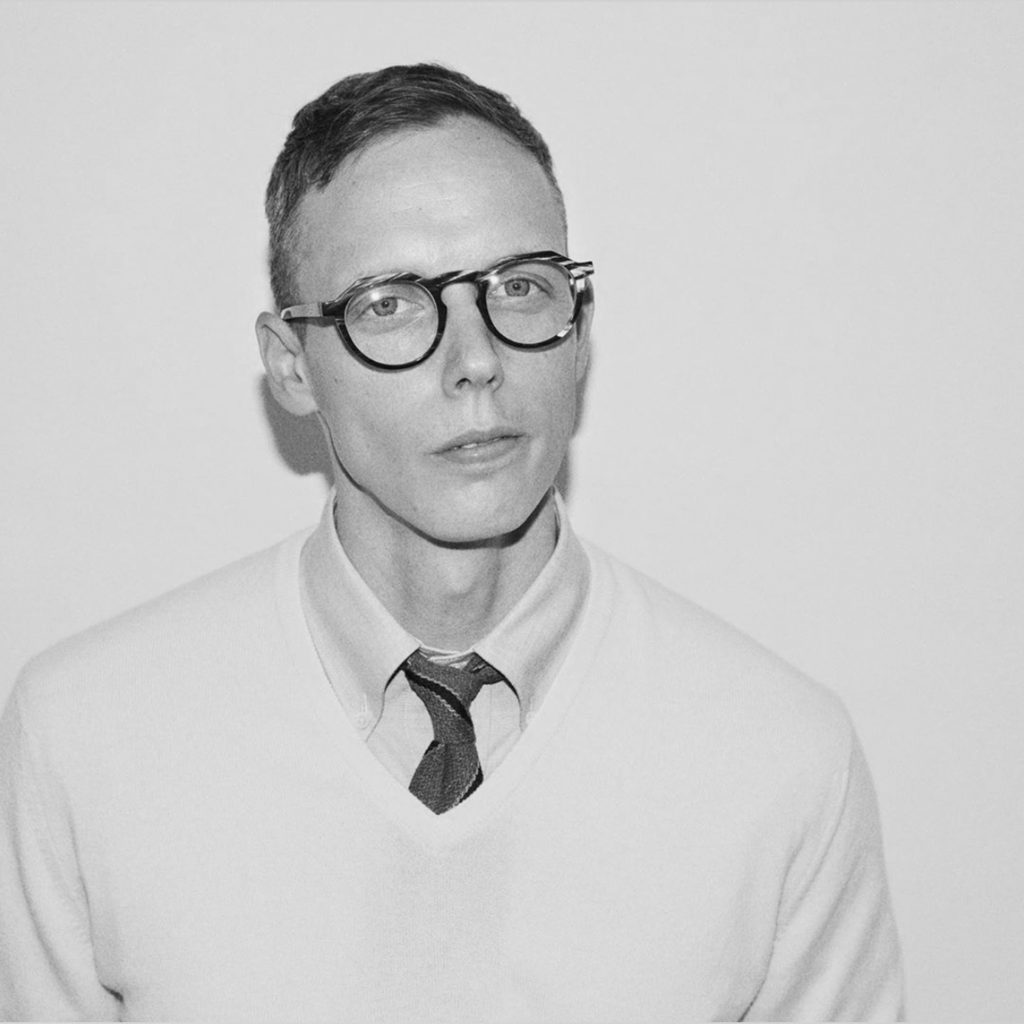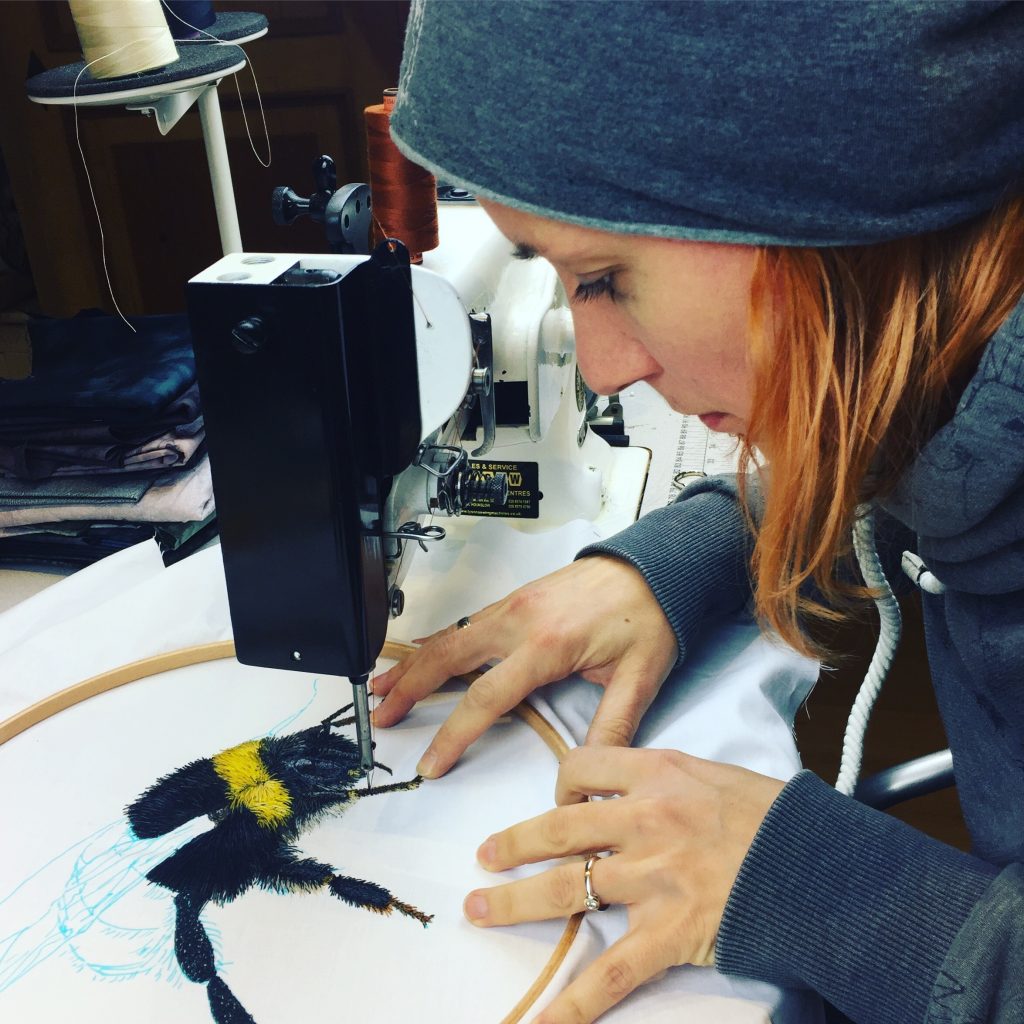Maryline Collioud-Robert Textile Artist - Boudry, Switzerland
There has been a strong and consistent growth in your quilts from the 1980’s through to today. Can you discuss how you keep developing your style?
I have no drawn path in front of me. I like to work in series, and it’s usually in the middle of creating a quilt that surges a bright idea for the next one. I do not produce many quilts, so I have series dating from years behind, I would like to add on to. I’m always 20 quilts in advance in my head, and curse time flying and everyday life taking so much time out of creation!
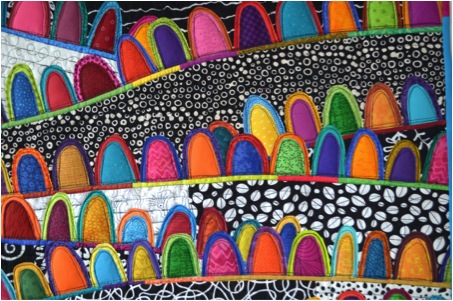
‘A Happy Place – detail’
Between 1980’s and 2000 your work was very colourful but piecing was the dominating factor, please expand on this?
I have always loved piecing and still do. There is magic in the math of patchwork, as well as a meditative and soothing effect in the repetition of blocks.
Between 2000 and 2010 you went beyond the boundaries. Explain how your work was no longer restricted by borders and templates?
Over the years, the quality of the surface, the colours and shapes have taken over the fascination of the puzzle inherent to patchwork piecing.
By 2006 and ‘Collage 2’ you have developed your own style. Can you explain the process you now use?
I appliqué/fuse fabrics to a background; I have hundreds of fabrics already fused, ready for use, and I choose among them, like I would choose colours for painting. I cut out the shapes by hand, and arrange them together until I get the intense colour surface I want.
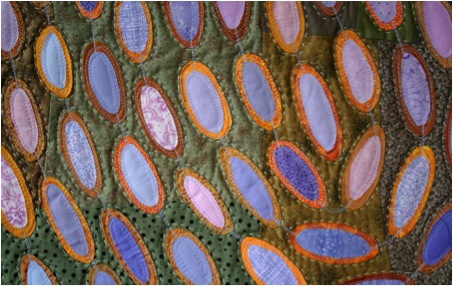
‘Gujarat – detail’
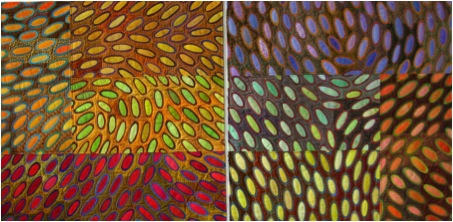
‘Gujarat’
With a work like ‘Fragments 3’ you have had to work at colour while also tone. Can you explain the importance of the knowledge and use of tone in your work?
I teach a colour workshop where I bring a large suitcase containing over a thousand different fabrics for the students to make collages with. At the end of the course, I collect the scraps, some as tiny as postage stamps. I use the small pieces of fabrics and I freely piece them to make the Fragments series./p>
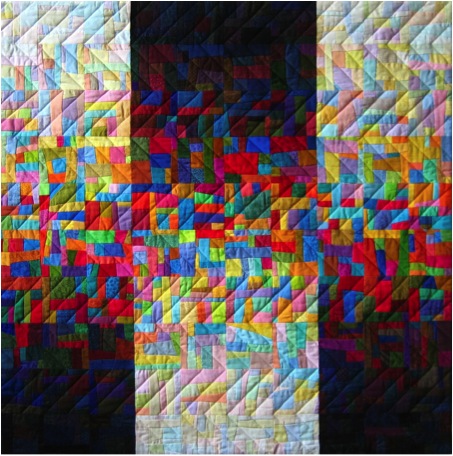
‘Fragment’
I love to make colour to colour or light to dark progressions. I always teach these progressions to my students, because one learns so much about colour in trying to make them.
Going from light to dark in one colour range is a lot easier than going from light to dark mixing all the colours. Quite a challenge, but I like to do that, it’s relaxing. It drains my brain of everything unwanted! I call this series, (Fragments), my yoga series!
In your recent work you use pattern in the background, as we can see in ‘Riflesso’. What has allowed this breakthrough?
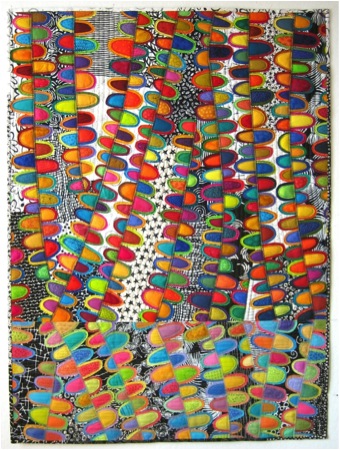
‘Riflesso’
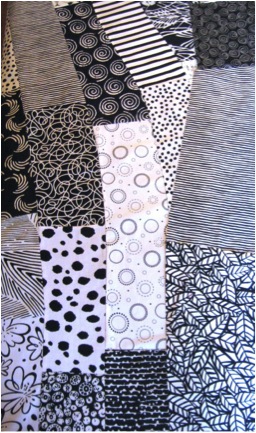
I’ve been using black and white fabrics for a while, because I like the intensified contrast it brings to the whole. For some reason, black and white fabrics are much more interesting, pattern wise, than some other fabrics created in other colour ranges.
I love my black and white fabrics, (I have built an impressive collection over the years) and I have a sketchbook where I sketch down some more inspiration to create new black and white fabrics! Maybe one day!…
You also combine machine and hand stitch – How do you know when enough is enough?
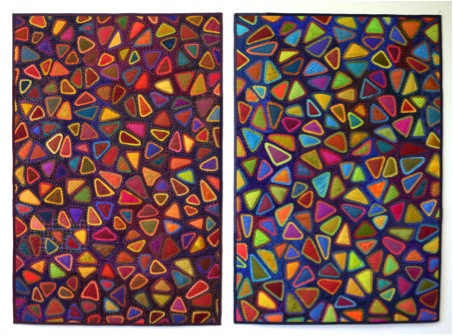
‘Epieces’
I’ve recently turned back to some hand stitching around my fused shapes, after coming back from India. Indeed, I was very lucky to take part to a trip to Gujarat, in the Kutch area, along with a group of textile lovers.
There, we visited several ethnical groups who each did a different kind of embroidery. I was struck by such beauty and expertise, although I’m not an embroiderer, and probably never will be. Some embroiderers were making incredible designs, and once finished, they went around the design with tiny white stitches. It’s in honour of their incredible work that I started hand quilting again.
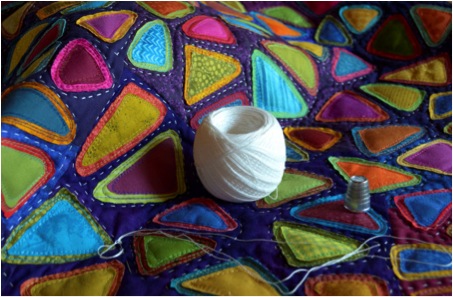
Can you discuss the piecing that you now use that creates such movement in your work?
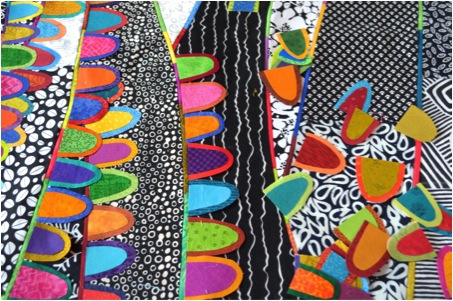
Working on ‘A Happy Place’
I build movement in the quilt by freely piecing background fabrics. The seams will then be the “stems” along which the shapes will be fused.
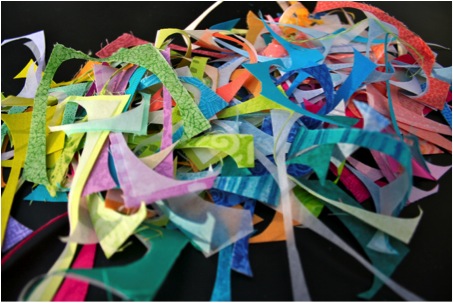
After cutting the shapes….
Colour is so important in your work. Where do you source your fabrics?
I’ve been buying fabrics for over thirty years, therefore I have a large choice. I’m not interested in printing or dying my own fabrics. (Perhaps in another life!). Going into shops all over the world and discovering new colours and new patterns is a great joy!
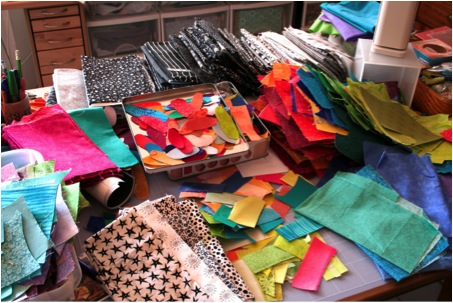
Maryline’s studio
‘Paysage Imaginaire’- how important is the colour wheel to your palette?
Sometimes I like to work within the colour wheel, such as in this red/green complimentary colours quilt. But I usually let myself be surprised by colour combinations I see around me. I used to carry a tiny notebook in which I described colour combinations I found on my way, using words as precise as possible, so I could recreate the combination once at home. Now I use my smartphone!

‘Passage Imaginaire’
You have travelled throughout the USA to discover quilts, can you tell about one or two very memorable events?
I was studying humanities at the University of Neuchâtel, while already creating quilts. I decided to go to the States to study quilts a little deeper, taking workshops, meeting artists, and visiting museums. This trip took over a year to prepare, as there was no internet then, and I remember writing over 200 letters to different people to organise my trip.
I also remember carrying in my suitcase, for months long, a tremendous amount of material for one workshop I was to take in Los Angeles. But on the week-end of the workshop, all we used was a sheet of paper and a pencil!
This trip was memorable. I was lucky to meet such wonderful artists such as Michael and Judy James, who became dear friends.
Exhibiting is a very large part of your studio time. How do you choose where to exhibit and how often?
It may seem like I exhibit quite a lot, but no, not so much. Quilting, at least the way I make quilts, takes an incredible amount of time, and to achieve a whole body of works for an exhibit takes ages.
Also, galleries in Switzerland are totally closed to exhibiting textiles. It’s hard to find convenient venues.
I belong to a professional Swiss quilt artists group, called fabric-connection.ch, and we have organised a few well received exhibitions, in Switzerland and in the States.
I also take part in international group exhibitions, whenever possible.
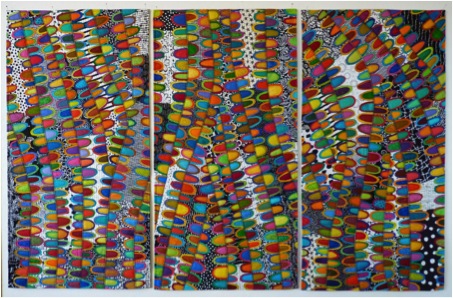
‘Ciao Bella!’
Everyone loves to see inside a studio. Can you share yours?
The main piece of furniture in my studio is a huge chest of drawers holding my fabrics. But I also have tons of fabrics outside of the main drawers as well!
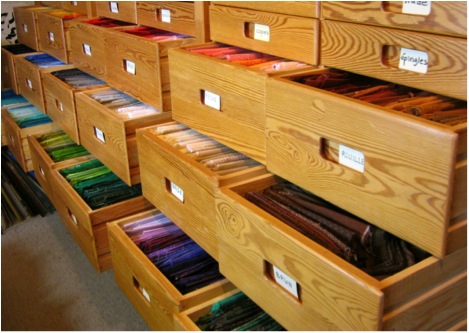
Can you tell us more about your teaching?
You have four classes can you share what each class brings to your students – “This workshop is especially convenient for people wanting to set a foot outside traditional quilting and wanting to develop some more personal work”?
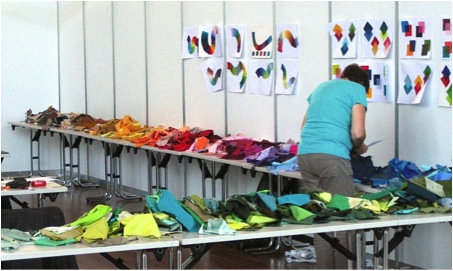
Teaching is one of my favourite occupations, besides making quilts. I love to transmit my love of colour and textile, share my enthusiasm about fabrics and to bring people to discover new worlds.
Most beginner feel secure making traditional quilts, which is perfectly all right, but I try to lead them a little bit outside their comfort zone. I also offer numerous exercises to make them discover new colour combinations, and I teach them how to use colour theories, everyday environment or just chance to be inspired.
Where do you teach these classes?
I’m lucky to go all over Europe to teach. Guilds, textile festivals, or private groups invite me.
It fuels my battery to be in a creative environment with eager students. I get to travel, make new acquaintances and get out of my lonely studio for a while!
What do you mean by the term ‘ephemerical quilt’?
No fear of the white page in my colour workshops! I give students instructions to work on an element (sometimes a quilt block) and all the blocs are then pinned to the wall. With a large surface obtained in a short amount of time, it’s easy to discuss colour, design, what could be changed, etc. The “group quilt” is photographed and then another one takes its place.
How important was it to your development to give up templates?
I think not only I, but many quilters have more or less given up templates. Nowadays, some incredibly creative people have developed quick, clever machine piecing techniques, and most important, shared their discoveries with the world, allowing everyone to be more spontaneous and more creative.
Can you share your photography with the blocks of colour?
My theory is that everyone, making even a very traditional quilt, will end up with a masterpiece, if they use variations of one colour, instead of just one colour.
I often advise people to buy 20 small pieces of different red fabrics rather than 2 meters of one single red fabric. I illustrate this every week on my blog, in choosing three colours taken out of one of my pictures, and working these three colours in “Vibrations”. The same can be done with combinations including more than 3 colours.
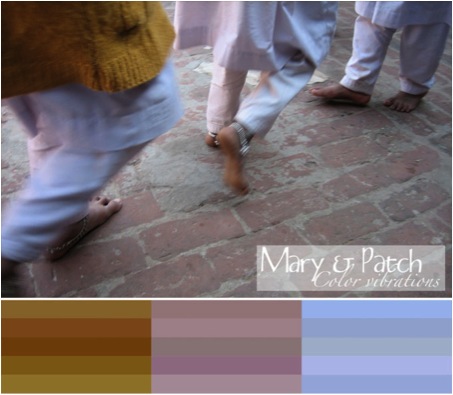
Can you explain how you use your photographs for inspiration?
Whenever possible, I carry my camera with me. I’m a very visual person, and I’m mostly inspired by things I see, rather than by things I hear or read.
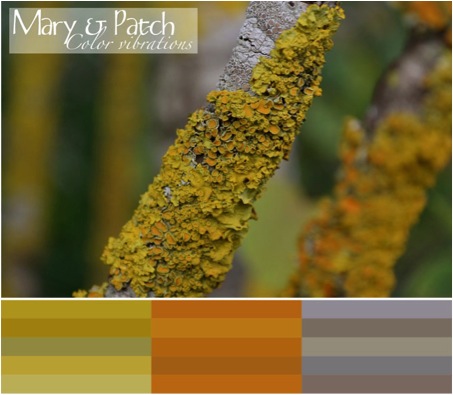
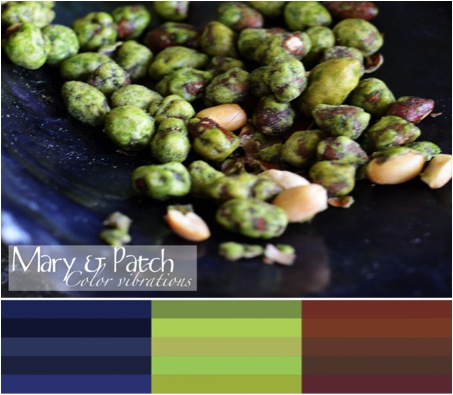
Colours, textures, nature, are my main inspiration.
What are you currently working on?
I’m working on a large quilt, black and white with coloured appliqué forms, arranged in a zig zag movement.
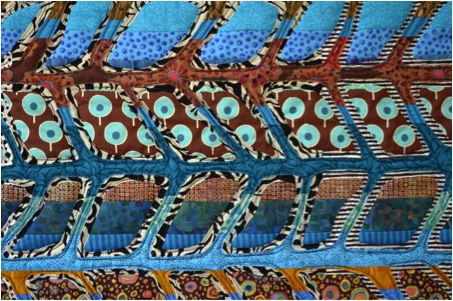
I’m also working on a new series, using reverse appliqué. That is sewing several layers of fabrics or whole patchwork surfaces, on top of one another, and making holes in the upper layer to reveal what’s underneath.
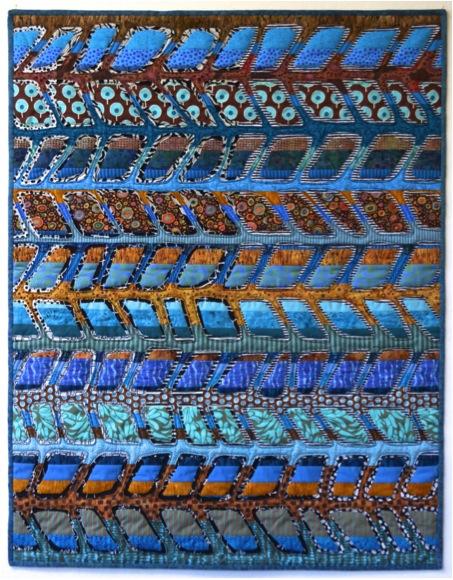
‘Spring’
Contact details.
m.collioud@me.com
www.marylinecollioudrobert.com
http://maryandpatch.blogspot.com
Maryline Collioud-Robert, Boudry, Switzerland
Interview by Deborah Blakeley, November, 2013
Think a colleague or friend could benefit from this interview?
Knowledge is one of the biggest assets in any business. So why not forward this on to your friends and colleagues so they too can start taking advantage of the insightful information the artist has given?
Other artists you may be interested in:

